 Nuclear-powered ballistic missile submarines (1958-61), service 1963-1994: Lafayette, Alexander Hamilton, Andrew Jackson, John Adams, James Monroe, Nathan Hale, Woodrow Wilson, Henry Clay, Daniel Webster (SSBN-616 -626).
Nuclear-powered ballistic missile submarines (1958-61), service 1963-1994: Lafayette, Alexander Hamilton, Andrew Jackson, John Adams, James Monroe, Nathan Hale, Woodrow Wilson, Henry Clay, Daniel Webster (SSBN-616 -626).Cold War US Subs
GUPPY | Barracuda class | Tang class | USS Darter | T1 class | X1 class | USS Albacore | Barbel classUSS Nautilus | USS Seawolf | Migraine class | Sailfish class | Triton class | Skate class | USS Tullibee | Skipjack class | Permit class | Sturgeon class | Los Angeles class | Seawolf class | Virginia class
Fleet Snorkel SSGs | Grayback class | USS Halibut | Georges Washington class | Ethan Allen class | Lafayette class | James Madison class | Benjamin Franklin class | Ohio class | Colombia class
The Lafayette class evolved from the Ethan Allen class, themslves a major development of the Skipjack-based G. Washington class, slightly larger and improved. With the sub-class James Madison, and Benjamin Franklin they made the most important contribution of the “41 for Freedom,” nuclear deterrent force in late 1980s, until basically their replacement by the game changing Ohio class. The James Madison and Benjamin Franklin sub-classes are placed by many authors in the same register, but will not be seen here and rather in their own specific posts. Specifics and design changes are to be however seen here in the surface. #usslafayette #usnavy #unitedsttesnavy #ssbn #strategicsubmarines #usdeterrence #polaris #coldwar
Maturity: The Lafayette SSBN superclass
The Lafayette class were the start of a continuous design lineage that will be followed until USS Will Rogers (SSBN-659) was completed at General Dynamics Electric Boat on 1st April 1967. From there, almost a decade commenced before the first of the next class, USS Ohio was laid down in April 1976. A decade dictated by post-Vietnam budget restriction under the Nixon/Ford administration and reevaluation of the submarine deterrence component. In between all the 31 submarine (not 43 as suggested by their numbers) of the Lafayette superclass as it sometimes known, made by far the bulk of the US ballistic submarine nuclear deterrence force, the core of the “41 for freedom”. Compared to the cuts made in the US Air Force, which severely restricted its traditional airborne deterrence component and mutated to ballistic missile land sites, these provided the Navy was a credible and essential “backup” in this policy as anybody knew about the sites across the continental united states, whereas submarines could be anywhere. They were already seen as a guarantee of “second strike”, an idea the Soviets developed further into the radical Typhoon class SSBN in the later 1970s.
The Lafayette were part of the Polaris programme, designed to carry initially the A2, but given its range limitations, were converted to the Polaris A3 as soon as it was available whereas the next Madison and Franklin classes were designed for the Polaris A3 from the start. It is important to note that the Lafayettes were designed and built BEFORE the Los Angeles class SSNs and many design specifics were introduced later and the object of upgrades. As for the specific of their design, they were essentially an improvement over the Ethan Allen class. The latter were a departure from the “emergency” Washington design based on a SSN hull, one of the first US Navy SSNs, the Skipjacks and their teardrop hull design.
The Lafayette were near-contemporary of the Sturgeon “superclass”and by numbers they mirrored these as some sort of “double standard”, the SSBNs and their escorts. There were 37 Sturgeon class boats and 31 Lafayette (and assimilated) so they were naturally paired.
The next Los Angeles and Ohio classes of the 1970s were much larger and a complete rethinking of their characteristics (as well as the whole US military) during and after Vietnam.
Development of the Lafayette class
The first eight were designed as a follow-up of the Ethan Allen with Polaris A-2 missile like the former, albeit in a more refine “package”. The hull was stretched and reworked, the “hump” containing the missile silos was more generous while being reshaped and more rational, in order to be refitted as soon as possible with the broader and longer ranged Polaris A-3. USS Daniel Webster, the last in class, was the first to have the A-3 from the start, and also to test the “minin sail” (see below). In the mid-1970s the same silos were found conventient to fire the compatible Poseidon C3 ballistic missile thanks to their missile tubes being larger than the Ethan Allen and George Washington classes. This enabled them the Poseidon unlike previous class and gave them a formidable improvement for the final decade of their service, helping their relevance. Indeed, these tubes were designed from the start to take advantage of larger tubes. They were not the “Polaris fit”. However unlike the similar James Madison and Benjamin Franklin classes they were not refitted with Trident I (C4) missiles for budgetary rerasons. Their tubes were compatible
Their age however made them less desirable.
The Lafayettes and successors also introduced a hovering system to better manage trim when firing missiles, increasing dramatically their rate of fire from one per minute to four per minute. This, added to the improved A3 and later Trident, made the whole superclass very efficient in their role.
USS Daniel Webster, last of the class, was originally built with diving planes mounted on a “mini-sail” near the bow and thus nicknamed “Old Funny Fins” in order to reduce the effect of “porpoising”. The result of downforce pulling the submarine down and blocking off the waterflow. It was successful but its operating mechanism bulged and reduced both her hydrodynamic efficiency, “reaking” the streamiling, lowered her overall speed and increase chances of detection. So after a while it was decided ti removed them by the mid-1970s during her Poseidon overhaul. Standard fairwater planes were back.
Design of the class
Hull and general design
The Lafayette class (named after Gilbert du Mothier, Marquis de Lafayette, French General in the American Revolution) was essentially stretched version of the Ethan Allen, with an extra section to better accommodate maintenance and crew needs. The stretch was not considerable, but they went from 410 ft 4 in (125.07 m) to 425 ft (130 m) for a totalk displacement at 7,325 long tons (7,443 t) Submerged: 8,251 long tons (8,383 t) versus 6,946/7,884 on the Ethan Allens. Beam was even reduced slightly to regain speed at 33 ft (10 m) just 1/10th feet less.
Draft was also reduced slighlty at 28 ft 6 in (8.69 m) versus 29 ft 10 in (9.09 m). In short they were more nimble but also more unwieldy. The biggest differences were in the hull shape.
The proportions were about the same with the identical ratios from the bow to the fin, which was a bit taller, and between the end of the “hump” forward to the tail. The silos were much larger however. The vertical tail was also taller. Dive planes were still on the sail, and somewhat reshaped. Otherwise the main water ingress scoops were located inside a “trench” running below the hump amidship, and the whole section reworked to eliminate bubbles and avoid any sound produced when sucking water/blowing air.
Powerplant
The same powerplant as on the Ethan Allen was reused, the now trusted S5W PWR (Pressurized Water Reactor). It also had the same geared steam turbines rated for 15,000 shp (11,000 kW) on a single shaft. But due to increase displacement and dimensions, top speed was 16 knots (30 km/h) surfaced and down to 21 knots (39 km/h) submerged versus 22 knots (41 km/h) submerged on the previous Allen class. Test depth was uncharged at 1,300 feet (400 m) as the construction materials or techniques were unchanged. The same design was repeated for the Madison and Franklin.
Armament
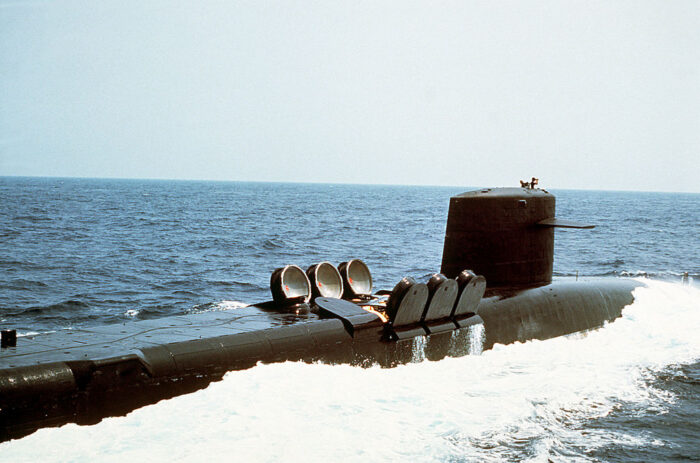
USS Woodrow Wilson showing her first three section’s missile hatches open.
Initially they were designed for the Polaris A3 and thus the tubes were mlade larger. However they were built faster than development of the new missiles and thus, operated the A2 in their early years of service before swapping on the A3.
Comparative Specifications Polaris A2:
Weight 38,000 lb (17,500 kg), 30 ft 9 in x 4 ft, 6 in. Powered by two solid-fueled stages, reactor to 8,000 mph (13,000 km/h) at 1,727 miles (2,700 km)
Carried the W47 1.2 ro 2 Mgt yeld Inertial guidance, satellite corrections for a CEP c1,500 meters (4,500 feet)
Main: 16x UGM-27C Polaris A3 SLBMs
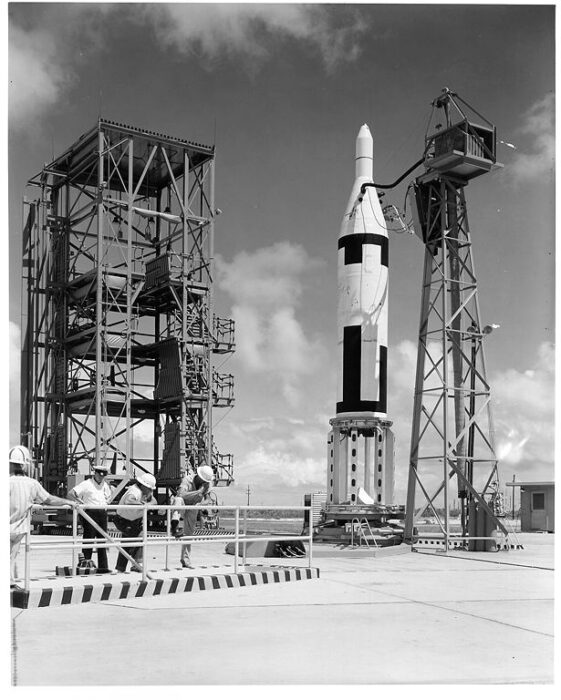
Like the Ethan Allen class they carried sixteen UGM-27 ballistic missiles, but the tubes were much larger for future upgrades. For the narrow A2, there was a modular “cradle” that maintained these in place and that could later receive broader missiles. Same for the well’s height which was greater also fore future taller payloads. The A2 carried a single warhead with a W47 thermonuclear bomb in a reentry vehicle. Read bout the full development of the Polaris and the teams working behind on the G. Washington post. The UGM-27B Polaris A2 under development in 1959 was longer by three feet and had a new Hercules second stage engine, rotary nozzle for thrust vector control. Its initial W-47-Y2 warhead however had reliability problems and from 1966 all were inspected and redone anew before beign phased out by September 1974, ending in tests.
The Polaris A3 was designed and manufactured by Lockheed Missiles and Space Division, introduced in 1964 and only gradually deployed on the Lafayette class. It stayed in service until 1981, SALT having them destroyed. The submarines that could not carry the Poseidon or Trident had their tubes filled with Concrete (such was the case of the Washington and Allen class). In short, the he A-3 had a range of 2,500 nautical miles and carried three W58 thermonuclear warheads, each with a yield of 200 kilotons.
It was the first capable of a range of 2,500 mile but larger compared to the A2 at 31 feet long (1.5 inches longer and 4.5 ft wider in diameter, 35,700 pounds (4,000 more) yet restricted in size enough to fit the same launch tube. Being capable to fly over 2500 nm versus 1500 nm was still a considerable upgrade. Its first stage weighted 24,600 lb and had a fiberglass motor case containing nitroplasticized polyurethane propellant while the second stage weighted 10,800 lb was in the same material but containing a composite modified double base propellant 9,000 Ib. There was at last the main engine EJC Hercules. On top was the Mk 11 guidance system (80 Ib) and reentry system with three “vehicles” (MIRV) tilted outboard, ejected by small rocket motor when at ideal pre-orbital trajectory.
With its 2500 nm range ideal for the Pacific Ocean it increase the submarine’s operating area and completely negated Soviet ASW capabilities. It also had the needed improved accuracy for penetrability of Soviet’s anti-ballistic missile defense. For this it had more advanced penetration aids (PenAids) with new trajectory shaping techniques. Many companyes collaborated to improve its electronics and materials as well as new concepts.
Guidance had to be improved while having half the space ad weight allocated to the A1 and A2 missiles. A brand new generation of inertial instruments and simplified computer mechanization was tested on modified A2 missiles from November 1961. Work was done also to improve reentry vehicle materials notably with a nylon-phenolic ablative heat shield.
Considerabvle advanced were done for the choice of better propellants, more resistant chamber materials and serch for more compact and efficient velocity control techniques. Moving from steel to high-strength resin-impregnated glass roving was one solution and the fixed spacing and orientation, ejection systems of the three MIRV was also improved for better penetrability.
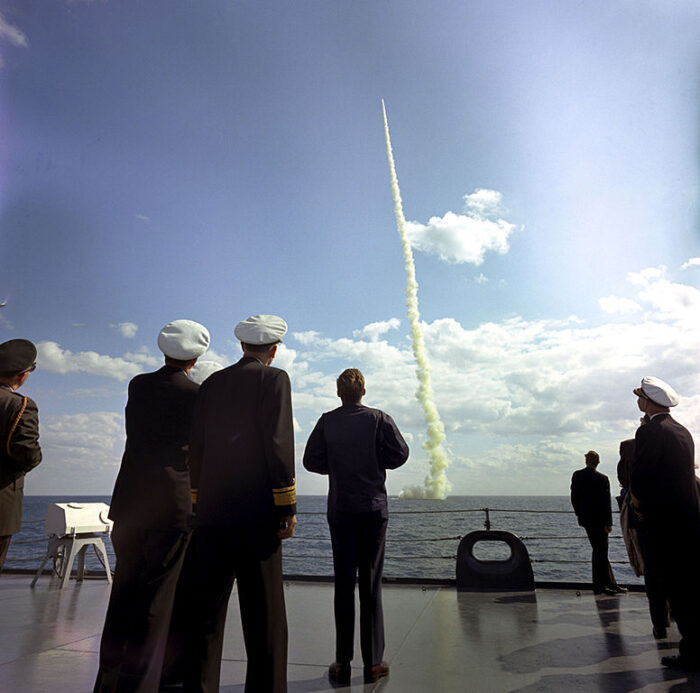
Launch of a Polaris A2 by USS Andrew Jackson witnessed by President J.F. Kennedy aboard USS Observation Island (E-AG-154) off the coast of Florida, November 16, 1963.
The first A3 flight test started at Cape Canaveral on 7 August 1962 and only bore fruit after the seventh development flight and introduced program A3X- 18 or “production disciplines”.
By June 1963, the A3X was tube-launched by USS Observation Island (EAG-154). USS Andrew Jackson (SSBN-619) launched the first on 26 October 1963.
The A3X program was completed on 2 July 1964 with 38 flights, 20 successes, 16 partial, 2 misses. 15 had a successful reentry vehicle hit. Work was donbe to corect issues between the propellant and nozzles notably by the use of the “cooler” propellant ANP 9969 and making the nozzles much larger and with tungsten throats to stop their erosion. There were issues also with their guidance computer (CLIP anomaly) linked to the umbilical disconnect and interface.
The Reentry System were the most difficult to fix, by betetr proofing the heatshield with thermal environment more severe than calculated.
Operational status was confirmed on 28 September 1964 on USS Daniel Webster (SSBN-626), the first to carry A3 missiles and first tube launched on 25 December 1964 by USS Daniel Boone (SSBN-629) in her Pacific patrol. The A3 missile provided a range of 2500 nm for the first time.
The POLARIS A3 OT program was suspended in January 1966 and was investigated by the Blue Ribbon Committee findings wich recommendations were implemented in September-December 1966 with upgrades and revision of all in February 1967 until October 1968 with better accuracy and reliability. The last A-3 in patrol was on USS Robert E. Lee on October 1, 1981.
Another point of note for the A3, was it was shared with Britain for the country’s first SSBNs, the Resolution class. These British A-3 were US made but had a British-manufactured warhead and were later upgraded to the Chavelin A-3TK variant. This was the first example of international collaboration of ballistic missiles.
⚙ specifications Polaris A3 |
|
| Weight | 36,000 Ibs (16,329 kg) |
| Dimensions | 32 ft (9.7 m) x 4 ft. 6 in (1.37 m) |
| Propulsion | 2-stage solid propellant |
| Speed | Supersonic, comparable to A2 |
| Range | 500 (926 km) – 2,500 n.miles (4,630 km) |
| Guidance | Inertial |
| Accuracy | 3,000 ft (900 m) C.E.P. |
| Payload | 3 MIRV W-58 nuclear 200 KT yeld each |
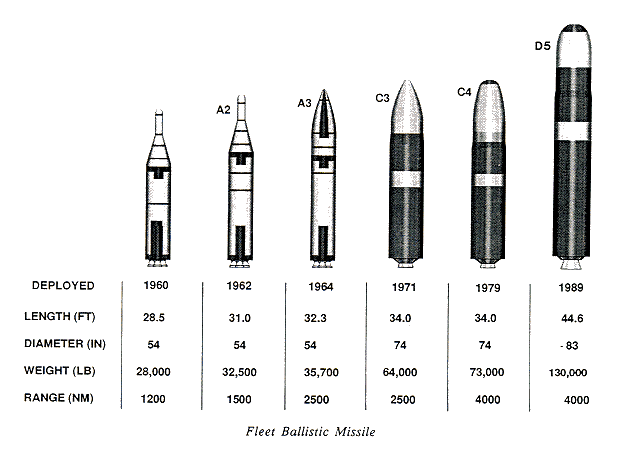
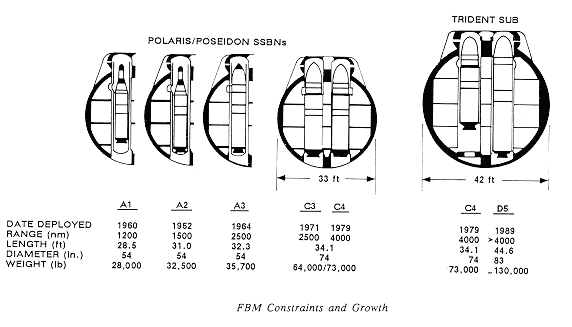
Comparison of sizes, SLBMs and respective silos Polaris A1 to A3, Poseidon C3/C4 (Madison/Franklin) and then Trident C4/D5 with a cut section of the Ohio class for scale. The shorter C4 was compatible with the Madison/Franklin but not installed on the Lafayettes. FAS, original USN doc.
UGM-73 Poseidon SLBMs
The UGM-73 Poseidon was a second generation USN nuclear-armed submarine-launched ballistic missile (SLBM) still with a two-stage solid-fuel rocket, replacing the UGM-27 Polaris from 1972 onwards, with advances in warheads and accuracy before replacement in 1979 by the Trident I and from 1990 by the Trident II. It will be more detailed on the next Madison class SSBN article.
⚙ specifications Poseidon C3 |
|
| Weight | 64,400 pounds (29,200 kg) |
| Dimensions | 34.1 feet (10.4 m) x 74 inches (1.9 m) |
| Propulsion | 2-stage solid-fuel rocket, thrust vectoring |
| Speed | 8,000 mph (13,000 km/h) terminal phase |
| Range | 3,200 nautical miles (5,900 km) with 10 MIRV |
| Guidance | Inertial |
| Accuracy | 0.3 nautical miles (560 m) CEP |
| Payload | 10-14 W68 warheads 40 kt each |
In 1968-1970, USS John Adams, James Monroe, Nathan Hale, Woodrow Wilson and Henry Clay swapped their Polaris A-2 SLBM (UGM-27B) for the A-3 SLBM (UGM-27C). Not Lafayette, and Webster had them from the start.
In 1974 started the Extended Refit Program (ERP), planned along overhauls approximately every 7 ½ years and resulting in decommissions for almost 2 years. To increase effectiveness it was decided t split these and preventive/corrective maintenances at a normal refit site with an extended 32-day refit/upkeep between patrols to 60-day as a 4-year/7 ½ year intervals and then 10 years for the latter. USS James Madison (SSBN-627) was the first which underwent such refit at Holy Loch in Scotland, between September and November 1974.
The same year in 1974, USS Nathan Hale, Will Rogers, Lafayette, Alexander Hamilton, Andrew Jackson and the next USS John Adams, Woodrow Wilson, as well as for 1976, James Monroe, Henry Clay, Daniel Webster had their Polaris replaced by Poseidon C-3 SLBM (UGM-73A).
For the next classes Madison and Franklin, we will see the Trident missiles. Lockheed commenced the TRIDENT I (C4) program started in November of 1973 with an entry servoce planned for 1979 for the new Ohio-Class submarines authorized in 1974. Under the Extended Refit Program (ERP) the C3 (Madison) to C4 (Franklin) SSBN were to benefit a “backfit” program by mid-1976. SSBN 629, 630, and 634 had a “pierside backfit”, SSBN 627, 632, and 633 during their drydocked shipyard overhaul.
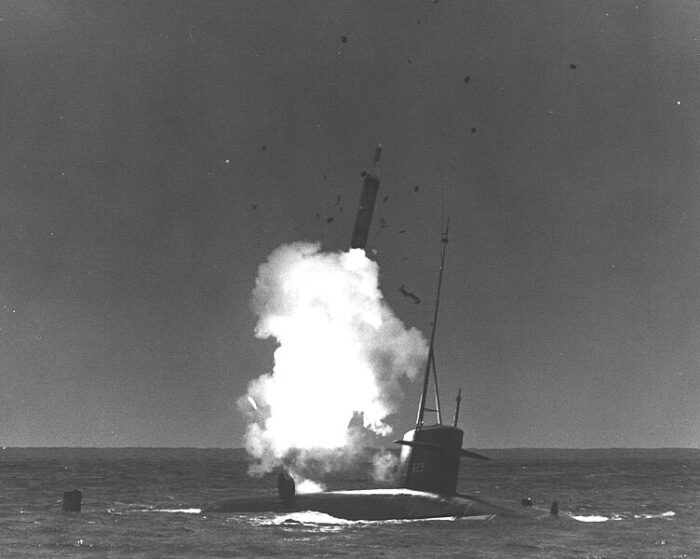
USS Henry Clay launching a Polaris A2 while surfaced after her shakedown cruise in April 1964.
Torpedo Tubes
Unlike the Washingtons, that kept all six 21-inch (533 mm) torpedo tube and a reserve lowered at 12 torpedoes, one per Mk 59 tube, the Ethan Allen class had two upper tubes removed, and the remainder pushed a bit lower in the bow chin. They were still initially of the same model, to carry the 1957 Mark 37 torpedoes (see the Washingtons for extra data).
However the Mark 59 were replaced by Mk 65 tubes and they kept the same 12 torpedo reserve. The main change was in the new torpedoes developed at the time. They indeed adopted the Mark 16 Mod 6 torpedoes initially, basically a modernized version of a 1943 design to replace the infamous Type 14. They were rugged and reliable, but not technologically advanced.
The Mark 37 replace these until themselves were replaced by the Mark 48.
Sensors
These SSBNs had a new suite: The BPS-11A radar, BQS-4A, BQR-7, BQR-15, BQR-19 and 21 sonars
BPS-11 radar
The AN/BPS-11 is a medium-range surface search and navigation radar searching in the X-band or I-band. Frequency 8 740 to 8 890 MHz, PRF 540 to 660 Hz
pulsewidth (τ) 0.5 µs at peak power 110 kW. Range 80 nm (148 km). Beamwidth 2.6°, up to 8 rpm rotation.
BQS-4A sonar
The BQS-4 was active sonar, here in its latest variant. The AN/BQS-4 is an active/passive detection sonar consisting in the AN/BQR-2 passive detection system and added active detection capability.
The BQS-4 active component comprised seven vertically stacked cylindrical transducers, located inside the BQR-2 chin bow dome to transmit its active “pings.”
In addition to passive listening, it can operate in either automatic echo-ranging or “single-ping” modes.
BQR-7 sonar
The AN/BQR-7 sonar is a long-range passive equipment installed on 594-class nuclear submarines. Target signals are recorded contiruously on a bearing-time-recorder display. A steered-beam audio display is also available for tracking one target at a time. The bearing of a particular target can be read from a dial on the operator’s console and the data can be transmitted automatically to the fire control system.
The hydrophones for the BQR-7 sonar are mounted in vertical staves, in groups of three, in a horseshoe configuration conforming to the shape of the submarine’s bow. There are 156 hydrophones
organized into 52 staves. Each stave has its individual amplifier for boosting the received signal. There are two independent compensator switches in the system. One compensator swit- feeds the BTR from the output of a continuously scanning beam rotated at a preset rate. The other switch, which is manually positioned, controls a narrow beam which presents the audio signal to the operator.
One compensator can automatically sweep and record target signals on the BTR while the other is used for manual search detection and tracking, The audio beam is trained in azimuth by a “steering wheel” control mounted on the console. The effectiveness of the BQR-7 passive sonar is reduced by own-ship noise during high-speed cruising. This apparently becomes critical over 5-6 knots.
The full description in a declassified document here
BQR-15 sonar
The AN/BQR-15 is a passive detection system including a thin line towed array (9080 line) coupled with the AN/BQR-23 signal processor. This array cable could be as long as 2,640 ft (800 m) long for a diameter of 0.5 in (12 mm). It is rolled down by a winch with hydraulic drive allowing the array to be streamed, retrieved or adjusted while submerged. It can be deployed in 15 minutes. This system was an upgrade in the late 1970s for the Ethan Allen class. It is part of the sonar suite carried by the the former SSBN-616 Lafayette class and current SSBN-726 Ohio class. More
BQR-19 sonar
Nicknamed “top hat”, this mast-mounted 1,000 pounds (454 kg) was an active, short-range and rapid-scanning submarine sonar for collision avoidance, navigation and other applications like upward-looking ice detection and mine detection. Its Initial operational capability (IOC) was attained in 1970 and it was deployed from the start on the OHIO-class submarines but also found its way on the upgraded Ethan Allen class.
BQR-21 sonar
Hull-mounted passive detection and tracking sonar, digital version of the BQR-2B with digital multibeam steering (DIMUS) coupled with the AN/BQR-24 signal processor and using both analog and digital processing techniques for a range of 100 miles (160 km) and tracking up to 5 targets simultaneously. Transducers were arranged in the bow conformal array, filling all available space as the torpeod tubes were relocated on the sides.

Conways profile of the Lafayette class
⚙ Lafayette class spec. |
|
| Displacement | 7,325 long tons (7,443 t), Submerged 8,251 long tons (8,383 t |
| Dimensions | 425 ft x 33 ft x 28 ft 6 in (130 x 10 x 8.69 m) |
| Propulsion | 1 shaft S5W PWR 2x geared steam turbines (15,000 shp (11,000 kW)) |
| Speed | 16 knots (30 km/h) surfaced, 21 knots (39 km/h) submerged |
| Range | Unlimited except by food supplies |
| Armament | 16x Polaris A2/A3 missiles, 4× 21-in (533 mm) TTs (12 torpedoes) |
| Sensors | BPS-11 radar, BQS-4A sonar, BQR-2 sonar |
| Test depth | 1,300 feet (400 m) |
| Crew | 2x 126 Blue/Gold (14 officers) |
Next: The Madison and Franklin classes
The James Madison class were an evolutionary development from the Lafayettes, identical except for being initially designed to fire the Polaris A-3, not the A-2.
⚙ Madison class spec. |
|
| Armament | 16 Polaris A3 missiles, later Poseidon, Trident, 4× 21-in (533 mm) TTs (12 torpedoes) |
| Sensors | BPS-11 radar, BQR-19 sonar |
The Benjamin Franklin class were the last development in this class (today they would be called “block III”), same hull and powerplant, missiles, and detailed improvements across the board, with a quieter machinery. Most sources make it a completely separate class and have the Madison/Lafayette one same class. The sub-class was the re-engineered SSBN 640 USS George C. Marshall built under the new SUBSAFE rules after the loss of USS Thresher while others were later retrofitted to meet SUBSAFE.
No data table here as it’s exactly the same as above.
The Lafayette class
 USS Lafayette (SSBN-616)
USS Lafayette (SSBN-616)
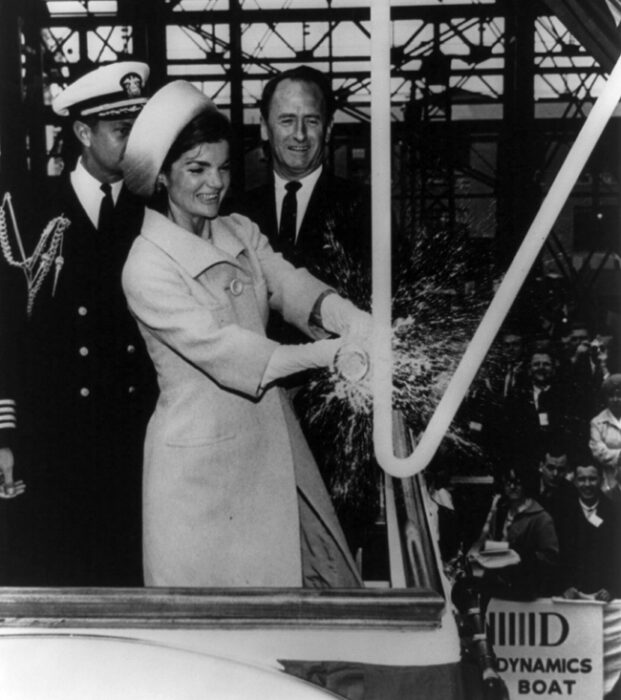
SSBN-616 was built at General Dynamics Electric Boat, laid down on 17 January 1961 and launched on 8 May 1962, completed on 23 April 1963 with Commander P. J. Hannifin (Blue Crew) and James T. Strong (Gold Crew). She made her shakedown in the Caribbean and loaded Polaris A2s at Charleston before sailing in June 1963 to Cape Canaveral for tested, firing four, two by each crew and moved to Groton for fixes from 2 August. Next she was in exercises with both crews alternated until her first patrol in the Atlantic from HP Charleston on 4 January 1964. For 4 years, she made 16 deterrent patrols from Rota, Spain. Her 15th won her a special commendation from Secretary of the Navy Paul Nitze. In August 1967 she started an overhaul at Newport News until 28 December 1968.
She resuled operations from 18 May 1969 at Charleston, 17th Polaris patrol, then two more and in 1970 four more. On 1 September 1971, she launched five Polaris A-2 missiles earning the crew a Meritorious Unit Commendation awarded on 11 May 1973.
In early 1972 she transited from Rota to New London in Connecticut for Commander Submarine Force, Atlantic and trained over 1,000 midshipmen praised by Rear Admiral Paul J. Early. Dr. Franklin B. Lincoln Jr., from the Foreign Intelligence Advisory Board toured USS Lafayette on 27 June. On 23 August she hosted students from the Naval War College in Newport and on 2 October hosted Mr. Leif Leifland, Minister Plenipotentiary to the Royal Swedish Embassy, then Rear Admiral Edwin E. McMorries the following day and author Joseph M. Duckert for his latest book.
After sound trials, Lafayette off-loaded missiles for her major 18 months Electric Boat yard overhaul and mount the Poseidon. Blue and Gold Crews were then a single overhaul crew from October 1972. This was completed on 7 November 1974. She embarked Vice Admiral Joe Williams, Jr., Atlantic Fleet CiC for her post-overhaul shakedown on 24–29 November. On 16 December Blue Crew launched the first Poseidon C-3 with Rear Admiral Levering Smith present as Director of the Strategic Systems Project Office and Rear Admiral Albert L. Kelln SubGroup 6 command as well as Air Force test range commander Gen. J. H. Ahmann. She had her Weapons System Accuracy Trials (WSAT) at St. Croix in the Virgin Islands, and Mk. 48 Torpedo Certification in Exuma Sound. Later in Groton she an eight-month post-conversion availabilit and made her 31st and 32nd patrols next. In 1976, she was based from Holy Loch in Scotland.
She test fired Mk. 48 torpedoes in Bahamas and had a refit at Charleston. She was back at Holy Loch in January 1977 for 37-40 deterrent patrols and by June launched two Poseidons.
She had her 1978 refit at Holy Loch before Patrol 43. 1979 saw 4 patrols and more Mk. 48 torpedo tests in Bermuda. In 1980 after thre patorls she was refitted at Groton and by early January 1981, hosted a dependents cruise from New London to Norfolk. Next she was dry docked at Newport News for an extended refuelling overhaul. In May 1984 she completed a shakedown with an Operational Reactor Safeguards Examination (ORSE) and Mk. 48 torpedo certification and by December embarked Gold crew for Patrol 52 and others in 1985 with Squadron 14, Holy Loch.
On 30 January 1986, while moored lose to the tender dock Los Alamos she was tossed on her during high winds and was repaired on 1–25 February before Patrol 60. After Patrol 63, she sailed for Charleston Weapons Station on 20 February 1987 followed by Patrol 64 but while leaving port she went off course and ran aground (dragging the rudder through the mud) but this led to a short Board of Inquiry. After Patrols 64 to 66 she was refitted at Holy Loch and during patrol 67 visited Lisbon in Portugal on 24–29 February 1988. After Patrol 69 she was refitted from 11 October. With Patrol 72 she made the first USN SSBN visit to Brest in France for Bastille Day celebrations. From Holy Loch in August she made Patrol 73, 74 from 22 February 1990, then Patrol 75 until 12 May 1990, and 76th was her last, completed 20 September 1990.
To test the class relevance she was pitted against SSN Boston trying to locate her until back to Groton on 19 December 1990 and tranfer to Bremerton in Washington for inactivation.
On 1 March 1991 USS Lafayette was decommissioned, stricken on 12 August 1991 and entered the Nuclear Powered Ship and Submarine Recycling Program at Bremerton, completed on 25 February 1992.
 USS Alexander Hamilton (SSBN-617)
USS Alexander Hamilton (SSBN-617)
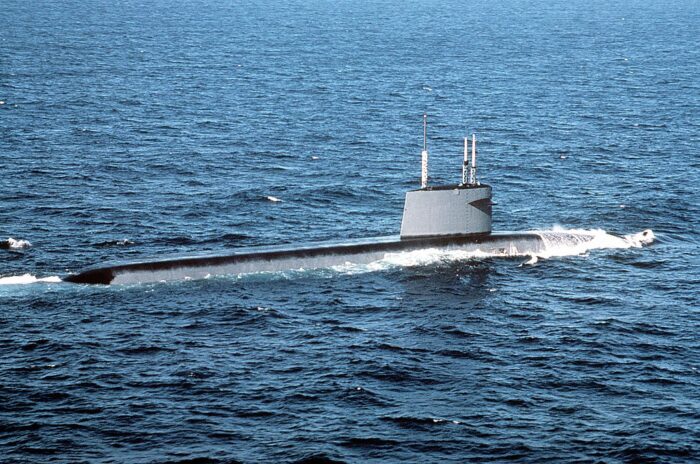
USS Alexander Hamilton at sea in 1991, note her “camouflage” of medium gray applied to her fin and upper sides. Otherse like Lafayette were painted also that way (see above). The space behind the fin’s diving planes is a shadow, not part of the camouflage.
SSBN-617 was laid down at the same yard as above, 26 June 1961, launched on 18 August 1962 and completed on 27 June 1963 with Commander Norman B. Bessac (Blue) and Commander Benjamin F. Sherman, Jr., (Gold). She made her shakedown between 28 June and 18 October 1963 and her her post-shakedown availability, trials early in 1964 and left on 16 March 1964 for Rota, Spain and her first deterrent patrols with Submarine Squadron 16. In January 1965 she was assigned to SubRon 14 at Holy Loch until 2 June 1967, before a refit at Charleston and later an overhaul at Electric Boat from 18 June 1967 with nuclear refueling until 28 June 1968 and after trials, inspections and shakedown completed by October she departed in November back to Rota for four years with Submarine Squadron 16 until her 31st patrol.
In Charleston from November 1972 to January 1973 she ahd her second refueling overhaul and refit to carry Poseidon missiles at Newport News over two years with shakedown in April 1975. Next she made her 32nd and 33rd patrols in early 1976 and 33rd at Holy Loch in May 1976. Later she visited Port Canavera and New London, then Charleston in March 1977 for a refit. She was back at Holy Loch in September 1977. She alternated until 1980 between there and Charleston. On March 3, 1981 she wa scaught in the nets of 73ft trawler Aquila from Campbeltown, towed astern for two miles until it was discovered. The trawler survived by repairs cost $3,200 covered by the US government, but this ended in a Navy Times February 19 1990 article.
In May 1982 she made patrol 56 under Marcus V. Friedma. In July 1982 she passed the Arctic Circle. In 1983 she stopped in Plymouth.
She went on in her patrols until 1986, and was schedule for decommission prior to the ratification of SALT II in Groton, with preparations for deactivation until the grounding of USS Nathanael Greene change these plans and she had instead a 4-week maintenance availability and returned in active service to Charleston and drydock USS Alamogordo. She served as a training platform and was back to Groton for training cruises of Naval Academy midshipmen. She had her refueling overhaul atPuget Sound from November 1987. Next she probably made her last deterrent patrols, but trhere are no records however she set a record on 28 April 1992 with her 1000th dive, at least for an SSBN. She was decommissioned and stricken on 23 February 1993 and disposed of through the Nuclear Powered Ship and Submarine Recycling Program at Puget Sound, completed on 28 February 1994.
 USS Andrew Jackson (SSBN-619)
USS Andrew Jackson (SSBN-619)
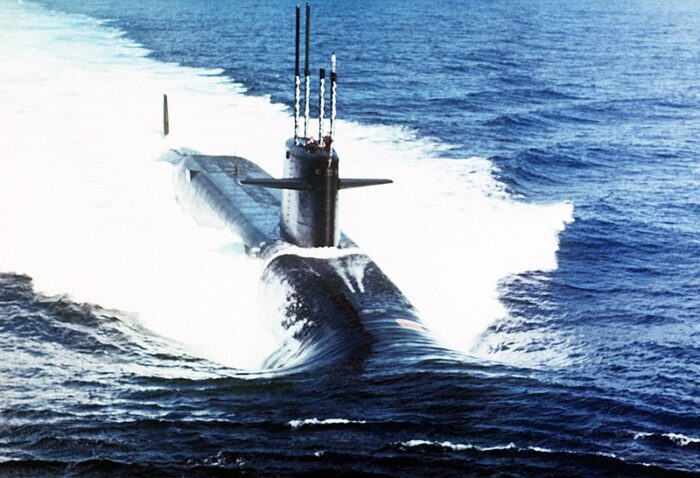
SSBN-619 was laid down at Mare Island Naval Shipyard on 26 April 1961, launched on 15 September 1962 and completed on 3 July 1963. She sailed via the Panama Canal for the East Coast and between 1 October and 11 October 1963 her had shakedown training off Cape Canaveral for a launchof Polaris A-2s. On 26 October 1963 she launched a Polaris A-3X into space while submerged and the same on 11 November 1963 observed by President John F. Kennedy on USS Observation Island, congratulating the submarine crew for “impressive teamwork.”
There was a 1967 Israeli attack on USS Liberty and controversy about what submarine observee the incident via its periscopes, submarine Andrew Jackson or USS Amberjack.
In 1988, the LBJ Presidential Library declassified a document dated 10 April 1967 with a document “submarine within U.A.R. waters” fuelling a Freedom of Information Act requests.
The 1981 book Weapons by Russell Warren Howe also accredited this hypothesis.
She was assigned to Submarine Squadron 16 Atlantic Fleet from 1964 to 1973, for patrols from Rota. No records for her service.
She was decommissioned on 31 August 1989 and stricken, then entered the Nuclear Powered Ship and Submarine Recycling Program in Bremerton, completed 30 August 1999.
 USS John Adams (SSBN-620)
USS John Adams (SSBN-620)
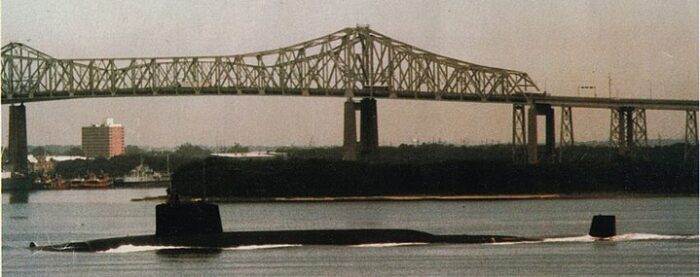
SSBN-620 was laid down at Portsmouth Naval Shipyard on 19 May 1961, launched on 12 January 1963 and completed on 12 May 1964. She completed sixteen deterrent patrols with the Atlantic Fleet before her major overhaul at Puget Sound with modernization in August 1968, completed overhaul on 10 August 1969, then reassigned to the Pacific Fleet. Both Blue and Gold Crews fire two Polaris in a Demonstration and Shakedown Operation post-overhaul. She then made sixteen more deterrent patrols and had her second major overhaul after her 32nd deterrent patrol at Portsmouth Naval Shipyard with conversion to the Poseidon, completed and returning to the Atlantic Fleet.
After 43 more deterrent patrols either from Charleston or Holy Loch, she was ordered through the Panama Canal and Puget Sound in preparation for decommissioning after 75 strategic deterrent patrols. She was decommissioned on 24 March 1989, stricken and entered the Nuclear-Powered Ship and Submarine Recycling Program at Bremerton, completed on 12 February 1996.
 USS James Monroe (SSBN-622)
USS James Monroe (SSBN-622)
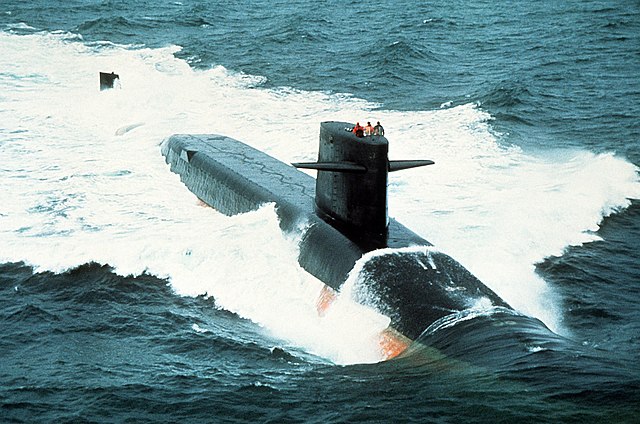
SSBN-622 (number skipped for SSN-621) was laid down at Newport News Shipbuilding and Drydock Company on 31 July 1961, launched on 4 August 1962 and completed on 7 December 1963 under Commander William H. Sandford (Blue Crew) and Commander Warren R. Cobean, Jr. (Gold Crew). After her shakedown off Cape Kennedy, she was in ballistic missile tests. She sailed for her first deterrent patrol in June 1964. On 17 January 1967, she made her 12th from Holy Loch, alternated with Rota in Spain. Commander Submarine Squadron 16 welcomed the tender USS Simon Lake at Kings Bay on 2 July 1979 and 4 days later, USS James Monroe entered, moored alongside her starboard side for a routine refit. No logs for the next deployments. She carried out probably around 70 deterrent patorls alternatiing between crews when decommissioned on 25 September 1990; stricken and assigned to the Nuclear Powered Ship and Submarine Recycling Program in Bremerton, completed on 10 January 1995.
 USS Nathan Hale (SSBN-623)
USS Nathan Hale (SSBN-623)
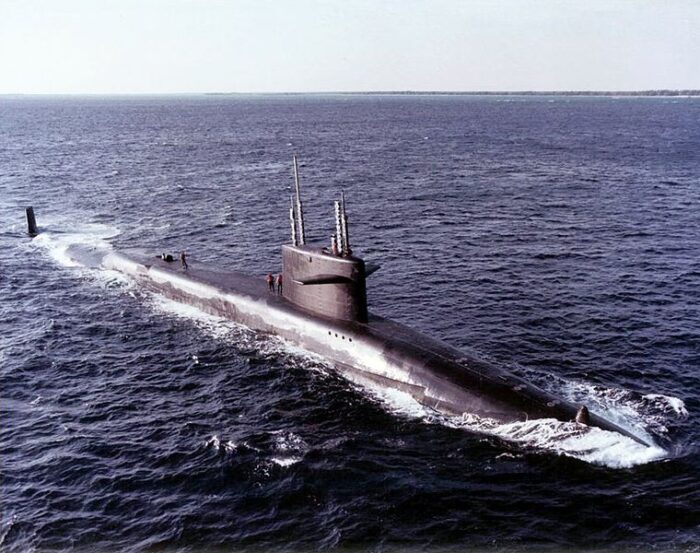
SSBN-623 was laid down at General Dynamics Electric Boat on 2 October 1961, launched on 12 January 1963, completed on 23 November 1963 in a subdued ceremony after the assassination of President John F. Kennedy a day before. She entered service on 21 May 1964, HP Charleston in South Carolina to start deterrent patrols with the Atlantic Fleet. In 1974 she was converted to the Poseidon missile system and before that in 1967-68 she had her first major overhaul and refueling before being transferred to the Pacific Fleet, Pearl Harbor alternated with Agana, Guam. By April 1986 she made her 69th and last deterrent patrol when she was decommissioned on 3 November 1986, stricken on 31 January 1987 and entered the Nuclear-Powered Ship-Submarine Recycling Program at Bremerton completed on 5 April 1994. She was portray the fictional U.S. Navy nuclear submarine USS Sawfish in the 1959 film “On the Beach” but the U.S. Navy did not cooperate so she was replaced by HMS Andrew (P423). She was featured also in the 1967 novel “Pre-Empt” by John R. Vorhies published in Oct. 1967 by Regnery.
 USS Woodrow Wilson (SSBN-624)
USS Woodrow Wilson (SSBN-624)
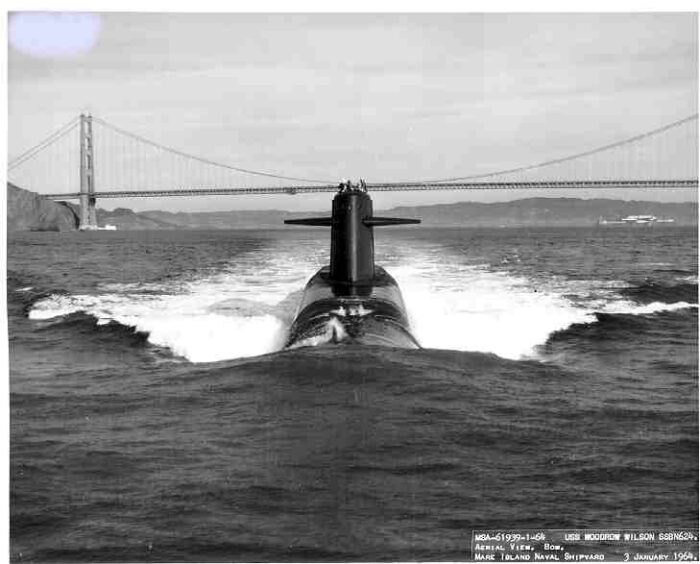
SSBN-624 was named after the United States WWI president, a more contemporary figure than the usual Revolutionary and early republican ones. She was laid down at Mare Island Naval Shipyard on 13 September 1961, launched on 22 February 1963 and completed on 27 December 1963 with Commander Cleo N. Mitchell in command (Blue) and Commander Walter N. Dietzen (Gold). She departed Mare Island on 9 January 1964 for the East Coast via San Diego, Panama and arriving on 19 January in an atmosphere of anti-American demonstrations and riots after an incident, proceeding through in seven hours ten minutes with combat-ready Marines and Army soldiers guarding locks. From Charleston on 5 February 1964 she made her shakedown cruise, post-shakedown repairs in April and trials, weapons qualif. by May 1964 then first deterrent patrol by June.
Patrols multiplied until the autumn of 1968, alternating from Rota, to Holy Loch, with stops for refits at Charleston and a 13-month overhaul/conversion to the Polaris A3 at Newport News. Next she was reassigned to the pacific fleet at Pearl Harbor, Hawaii on 19 November 1969 alternated with Guam, Apra Harbor until 1972. In 1972, she was recalled to the Atlantic and had another major overhaul, Poseidon conversion at Newport News, and reassigned to Charleston HP. On 4 June 1979 she ran aground in heavy fog at Race Rock near New London but free herself and proceed to port for inspection of damage and repairs.
After 40 more deterrent patrols she entered Charleston for her last overhaul in 1988 until CDR Charles Peterson was relieved by August 1989. Hurricane Hugo struck on 21 September 1989 in which crew members helped with recovery operations, being awarded the Humanitarian Service Medal. She had her Alfa sea trials in June 1990 but due to SALT II she saw the deactivation of her missile system and was converted into an SSN, making her Shakedown three months ahead of schedule. She had AUTEC, WSAT and open ocean exercise while her missile compartment was reconfigured for support spec ops, with Tactical Readiness Evaluation. She was assigned to SubRon 4 at Charleston earning “A” for excellence in ASW. Sghe took part in Atlantic NATO Exercises, and to Naval Special Warfare tactics. In September 1991 she took part in Phantom Shadow largest Navy Special Warfare exercise between the Western Atlantic and Caribbean. In the spring of 1992 she had a MK 48 warshot SINKEX after overhaul. She was deactivated in September 1993, decommissioned on 1 September 1994, stricken the same day and entered the Nuclear Powered Ship and Submarine Recycling Program at Bremerton, completed on 27 October 1998.
 USS Henry Clay (SSBN-625)
USS Henry Clay (SSBN-625)
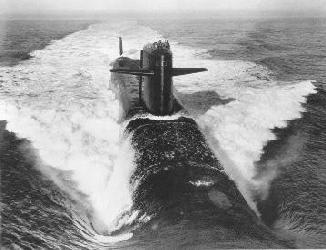 SSBN-625 or Henry Clay was laid down at Newport News on 23 October 1961, launched on 30 November 1962 and completed on 20 February 1964 with Commander Thomas A Bryce (Blue) and Commander John C. Lewis (Gold). She had a shakedown off Florida from 28 February 1964 and performed her first submerged Polaris fire on 6 April 1964 , then post-shakedown fixes at Newport News on 29 May 1964.
SSBN-625 or Henry Clay was laid down at Newport News on 23 October 1961, launched on 30 November 1962 and completed on 20 February 1964 with Commander Thomas A Bryce (Blue) and Commander John C. Lewis (Gold). She had a shakedown off Florida from 28 February 1964 and performed her first submerged Polaris fire on 6 April 1964 , then post-shakedown fixes at Newport News on 29 May 1964.
She was homeported at Charleston, starting her first deterrent patrol on 17 August 1964 and made her 11th on January 1967. She was assigned in May to SubRon 14.
In December 1986 she stopped at Plymouth, sole stop between April 1985 and October 1987.
In 1987, she had an unannounced Operational Reactor Safeguards Examination receiving the EXCELLENT grade, only time it happened after the USS Hyman G. Rickover (SSN-709).
In 1989 she was refitted in Holy Loch, and onloaded 250,000 pounds of food. She made next a record of 121 days between April and August in North Atlantic with later port calls in Plymouth and Portsmout and back to Norfolk for R&R and a 2-day, “Tiger Cruise” at Charleston with families.
She was decommissioned on 5 November 1990, stricken and later entered the Nuclear Powered Ship and Submarine Recycling Program in Bremerton, completed on 30 September 1997.
 USS Daniel Webster (SSBN-626)
USS Daniel Webster (SSBN-626)
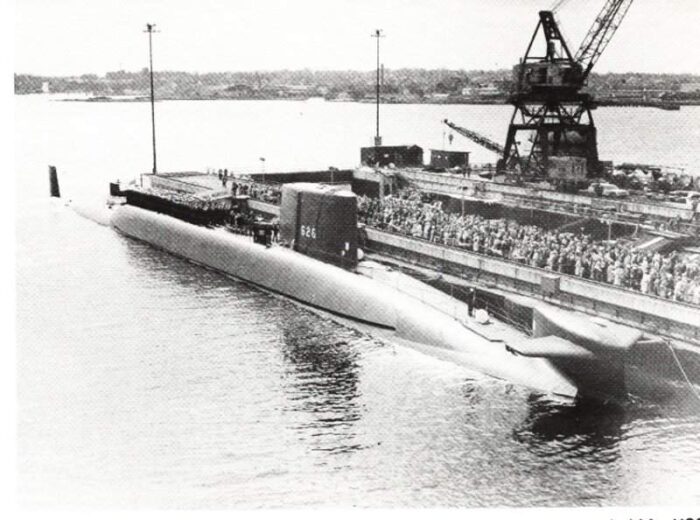
Daniel Webster showing after completion her rather strange “double fin” with experimental large diving planes, nicknamed “Olf funny Fins”.
SSBN-626 was laid down at General Dynamics on 28 December 1961, launched on 27 April 1963 and completed on 9 April 1964 with with Commander Marvin S. Blair (Blue) and Commander Lloyd S. Smith (Gold). She was the first completed with the A3 Polaris and to feature an experimental sail with extra fairwater planes forward, tested but not repeated. While in service she was the last retrofitted for the UGM-73 Poseidon.
Her Patrol 50 was in July 1982 from Holy Loch. For Patrol 56 March 1984 she ahd a port call in Naples (same in 1987). She was sent at the Naval Weapons Station, Charleston by March 1985. In Patrol 68 in Nov. 1987 she had a port call in Lisbon, Portugal. She was decommissioned on 30 August 1990, stricken, converted to a moored training ship to be a S5W reactor prototype training facility at Charleston Naval Shipyard and renamed MTS-626, towed up-river at the Naval Nuclear Power Training Unit Charleston. She is still there today.
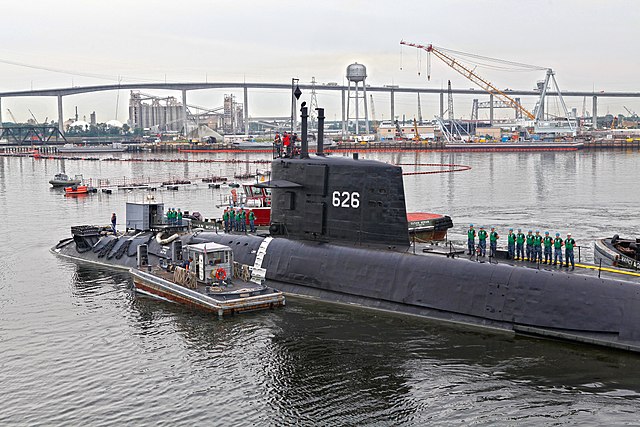
Daniel Wester in Nortfolk prior to inactivation.
Read More/Src
Links
history.navy.mil uss-lafayette
nuclearcompanion.com/
navsource.org/
nuke.fas.org/
airandspace.si.edu/ polaris-3
spaceline.org/ lafayette-class-submarines/
en.wikipedia.org/ Lafayette-class_submarine
nuclearcompanion.com polaris-a-3
nuke.fas.org ssbn-secure
nationalinterest.org/
Videos
another video
Rare 1964 16mm Silent Film of USS Daniel Webster testing the “Funny Fins” off Cape Canaveral.
Model Kits
Andrew Jackson Renwal 1:200, Nuclear Submarine SSBN Andrew Jackson Revell 1:200.
Lafayette Class USS Daniel Webster SSBN-626 Blue Water Navy 1:350 and UA MikroMir 1:350, USS Lafayette SSBN-616 UA MikroMir 1:350
SSBN-626 USS Daniel Webster Yankee Modelworks 1:350
USS Lafayette class submarine OKB Grigorov 1:700, USS Daniel Webster SSBN-626 OKB Grigorov 1:700
USS Daniel Webster SSBN-626 Model Monkey 1:700 & USS Andrew Jackson SSBN-619 1:700
General scalemates query
on sdmodelmakers.com/
Oddball
Lafayette-class USS Daniel Webster (SSBN-626), aka "Old Funny Fins/Daniel Dumpster" in a dry dock, Guam, with her unique mini-sail on the bow. More info in comments.
byu/Saturnax1 insubmarines

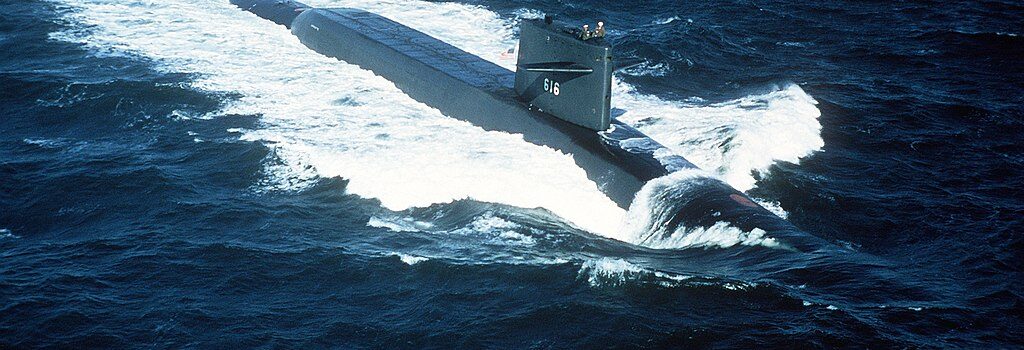


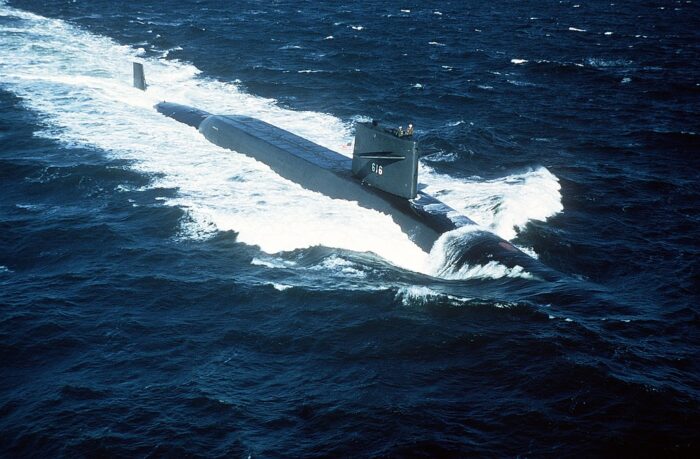
 Latest Facebook Entry -
Latest Facebook Entry -  X(Tweeter) Naval Encyclopedia's deck archive
X(Tweeter) Naval Encyclopedia's deck archive Instagram (@navalencyc)
Instagram (@navalencyc)





 French Navy
French Navy Royal Navy
Royal Navy Russian Navy
Russian Navy Armada Espanola
Armada Espanola Austrian Navy
Austrian Navy K.u.K. Kriegsmarine
K.u.K. Kriegsmarine Dansk Marine
Dansk Marine Nautiko Hellenon
Nautiko Hellenon Koninklije Marine 1870
Koninklije Marine 1870 Marinha do Brasil
Marinha do Brasil Osmanlı Donanması
Osmanlı Donanması Marina Do Peru
Marina Do Peru Marinha do Portugal
Marinha do Portugal Regia Marina 1870
Regia Marina 1870 Nihhon Kaigun 1870
Nihhon Kaigun 1870 Preußische Marine 1870
Preußische Marine 1870 Russkiy Flot 1870
Russkiy Flot 1870 Svenska marinen
Svenska marinen Søværnet
Søværnet Union Navy
Union Navy Confederate Navy
Confederate Navy Armada de Argentina
Armada de Argentina Imperial Chinese Navy
Imperial Chinese Navy Marinha do Portugal
Marinha do Portugal Mexico
Mexico Kaiserliche Marine
Kaiserliche Marine 1898 US Navy
1898 US Navy Sovietskiy Flot
Sovietskiy Flot Royal Canadian Navy
Royal Canadian Navy Royal Australian Navy
Royal Australian Navy RNZN Fleet
RNZN Fleet Chinese Navy 1937
Chinese Navy 1937 Kriegsmarine
Kriegsmarine Chilean Navy
Chilean Navy Danish Navy
Danish Navy Finnish Navy
Finnish Navy Hellenic Navy
Hellenic Navy Polish Navy
Polish Navy Romanian Navy
Romanian Navy Turkish Navy
Turkish Navy Royal Yugoslav Navy
Royal Yugoslav Navy Royal Thai Navy
Royal Thai Navy Minor Navies
Minor Navies Albania
Albania Austria
Austria Belgium
Belgium Columbia
Columbia Costa Rica
Costa Rica Cuba
Cuba Czechoslovakia
Czechoslovakia Dominican Republic
Dominican Republic Haiti
Haiti Hungary
Hungary Honduras
Honduras Estonia
Estonia Iceland
Iceland Eire
Eire Equador
Equador Iran
Iran Iraq
Iraq Latvia
Latvia Liberia
Liberia Lithuania
Lithuania Mandchukuo
Mandchukuo Morocco
Morocco Nicaragua
Nicaragua Persia
Persia San Salvador
San Salvador Sarawak
Sarawak Uruguay
Uruguay Venezuela
Venezuela Zanzibar
Zanzibar Warsaw Pact Navies
Warsaw Pact Navies Bulgaria
Bulgaria Hungary
Hungary

 Bundesmarine
Bundesmarine Dutch Navy
Dutch Navy Hellenic Navy
Hellenic Navy Marina Militare
Marina Militare Yugoslav Navy
Yugoslav Navy Chinese Navy
Chinese Navy Indian Navy
Indian Navy Indonesian Navy
Indonesian Navy JMSDF
JMSDF North Korean Navy
North Korean Navy Pakistani Navy
Pakistani Navy Philippines Navy
Philippines Navy ROKN
ROKN Rep. of Singapore Navy
Rep. of Singapore Navy Taiwanese Navy
Taiwanese Navy IDF Navy
IDF Navy Saudi Navy
Saudi Navy Royal New Zealand Navy
Royal New Zealand Navy Egyptian Navy
Egyptian Navy South African Navy
South African Navy






























 Ukrainian Navy
Ukrainian Navy dbodesign
dbodesign
I’m kind of confused about “From there, almost a decade commenced before the first of the next class, USS Ohio was laid down in April 1976. A decade dictated by post-Vietnam budget restriction under the Carter administration and reevaluation of the submarine deterrence component” since Carter didn’t take office until 1977. Maybe you meant Nixon/Ford?
Indeed, well spotted, thx. This website really needs a proofreader.